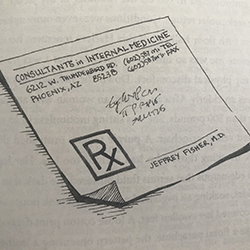Physician Shares 45 Years of Knowledge with Next Generation of Health Care Providers

As an internist, Dr. Fisher’s career has allowed him to care for some of the most vulnerable patients — from treating individuals from underserved backgrounds at Harlem Hospital, caring for the Native American community through the Indian Health Service, traveling to Russia as part of a medical team, to working in a private practice in Glendale, Arizona. Through these unique experiences and patient interactions, Dr. Fisher learned valuable lessons from his patients that he wanted to share with medical students, so they could consider the rewards of working in primary care. In an effort to do so, he began working at the medical school teaching case-based instruction (CBI) to first-year medical students, and he published a book sharing a few of his remarkable patient stories titled “Postscripts: For a Doctor From His Patient.”
“I had a great career in internal medicine, and I loved it,” Dr. Fisher said. “Through this book and my teachings, I want to encourage medical students to consider the primary care field. It’s an area we so desperately need these days. Additionally, it is my hope that these stories will encourage students to explore the unique relationships that can develop between doctor and patient. They then will discover stories and experiences of their own.”
Dr. Fisher started teaching medical students at the College of Medicine – Phoenix about one year ago. CBIs help students think medically. Instructors will present a case to a group of about seven students, who work to understand symptoms, testing, diagnosis, treatment and social determinants of health. Cases include common and rare conditions — from back pain to cystic fibrosis. At closing, students will go over results and take some aspect of that diagnosis and do a presentation regarding what they learned.
“Students are really learning how doctors think,” Dr. Fisher said. “These sessions cover everything, including the basic science, the clinical evaluation, to even trying to treat that patient with their situation — like lack of transportation or health insurance.”

Dr. Fisher decided to become an educator after getting sick in 2010 when he stepped on a metal shard in the garage and got an infection in his foot. He went to a dermatologist a few days later for another problem and mentioned his foot. The dermatologist dug out a piece of metal, but two days later he got sepsis. He had staphylococcal septicemia, a severe infection that led him to three weeks in the hospital with a vertebral abscess, an abdominal abscess, meningitis and ultimately, a pulmonary embolism. Doctors discovered that Dr. Fisher had leukemia, which transformed to Hodgkin's Disease.
After the diagnosis, Dr. Fisher made the decision to retire from his practice and dedicate his time to educating future physicians and health providers through his book and teaching CBIs.
“I enjoyed being a doctor all these years, and I wanted to apply that to teaching,” Dr. Fisher said. “I learned more about the program at the College of Medicine – Phoenix through one of my friends, Bob Kravetz, MD, who teaches at the medical school. I shadowed him and then started teaching. It was a way to use my medical skills and make a difference.”
Dr. Fisher added that through his illness, he experienced what it was like to be a patient, rather than a physician. “I learned a lot by being a patient, and it reinforced a few things that I already knew — like the importance of communication with patients and families.”
A year after his diagnosis, Dr. Fisher began writing his book. He said that it was really the support and motivation from his wife, Diana, that made him write down some of his most unique experiences and the lessons he learned along the way. The book is designed for medical students, health providers and the lay audience as it addresses the importance of the physician-patient relationship.

“As medicine, we refer to scripts as prescription,” Dr. Fisher said. “These postscripts are the ways the patient has instructed me about them. In other words, during the time I was treating them for their illness, they were instructing me what it was like to be them as an individual and as a person with that disease. So, for as long as I was treating the patient, I was learning from them as much as I was giving to them. In primary care, that is what we do.”
All proceeds from Dr. Fisher’s book go to providing first-year medical students with a copy.
Topics
About the College
Founded in 2007, the University of Arizona College of Medicine – Phoenix inspires and trains exemplary physicians, scientists and leaders to advance its core missions in education, research, clinical care and service to communities across Arizona. The college’s strength lies in our collaborations and partnerships with clinical affiliates, community organizations and industry sponsors. With our primary affiliate, Banner Health, we are recognized as the premier academic medical center in Phoenix. As an anchor institution of the Phoenix Bioscience Core, the college is home to signature research programs in neurosciences, cardiopulmonary diseases, immunology, informatics and metabolism. These focus areas uniquely position us to drive biomedical research and bolster economic development in the region.
As an urban institution with strong roots in rural and tribal health, the college has graduated more than 1,000 physicians and matriculates 130 students each year. Greater than 60% of matriculating students are from Arizona and many continue training at our GME sponsored residency programs, ultimately pursuing local academic and community-based opportunities. While our traditional four-year program continues to thrive, we will launch our recently approved accelerated three-year medical student curriculum with exclusive focus on primary care. This program is designed to further enhance workforce retention needs across Arizona.
The college has embarked on our strategic plan for 2025 to 2030. Learn more.